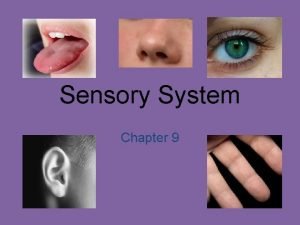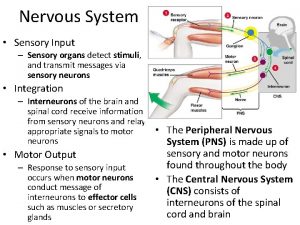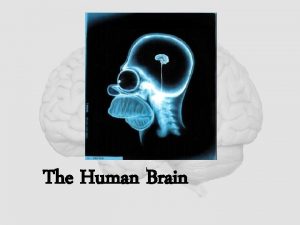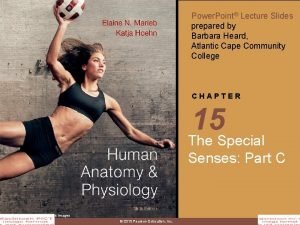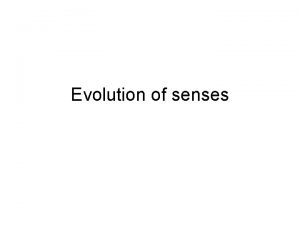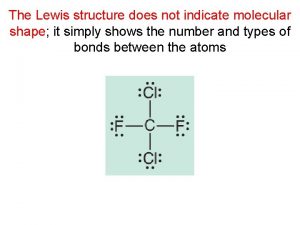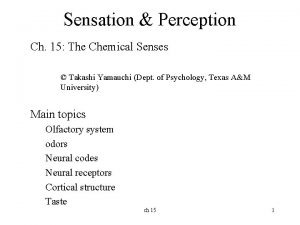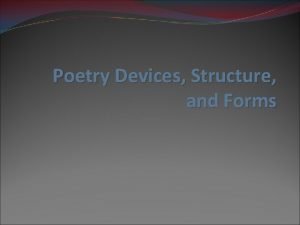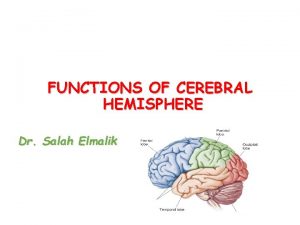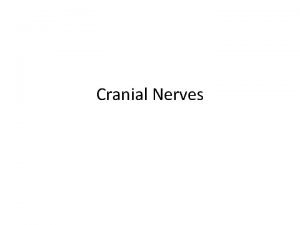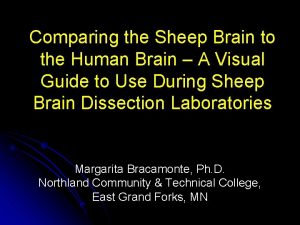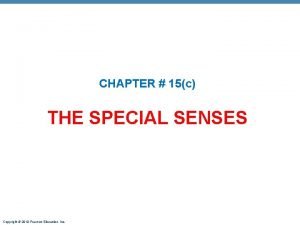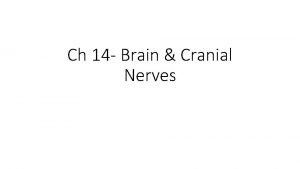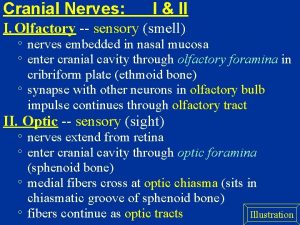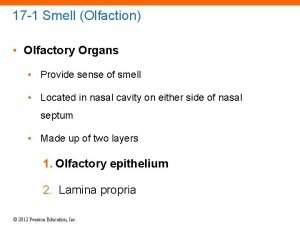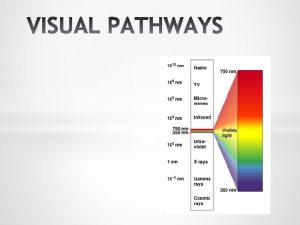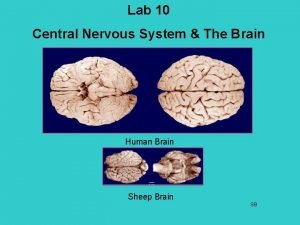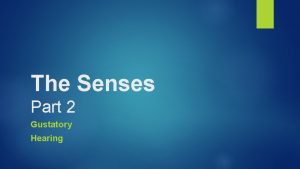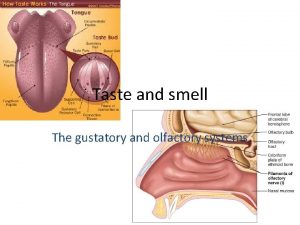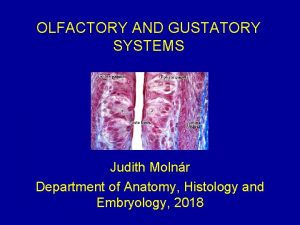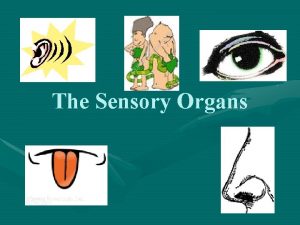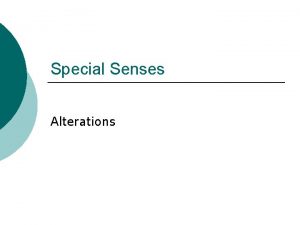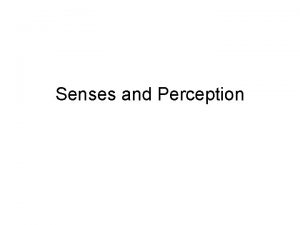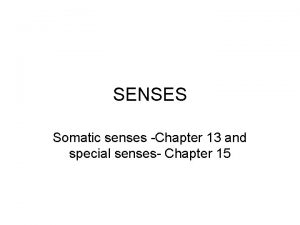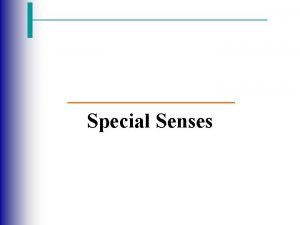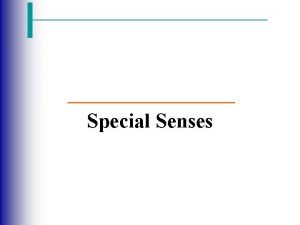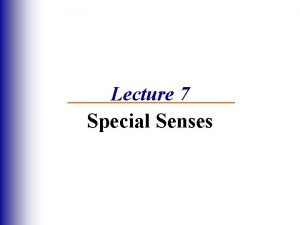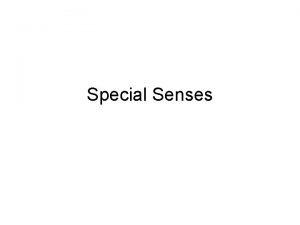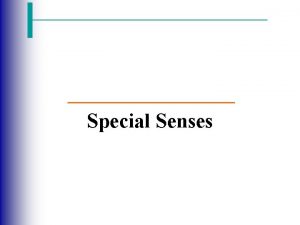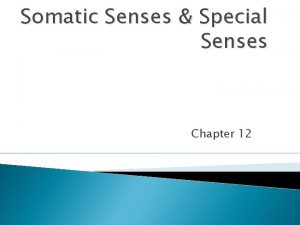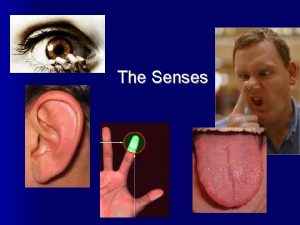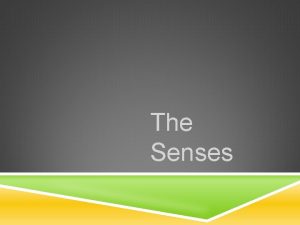Sensory Organs Olfactory Gustatory and Hearing Senses Sensory






























- Slides: 30

Sensory Organs Olfactory, Gustatory, and Hearing

Senses • Sensory Receptors - detect environmental changes and trigger nerve impulses • - Somatic senses (touch, pressure, temp, pain) • - Special senses (smell, taste, vision, equilibrium, hearing)

Receptors • 1. Chemoreceptors = detect chemical changes 2. Pain receptors = detect pain • 3. Thermoreceptors = detect temperature changes • 4. Mechanoreceptors = detect touch • 5. Photoreceptors = detect light

Sensations • Sensation = feeling that occurs when a brain interprets a sensory impulse • Projection = process where the cerebral cortex causes a feeling to stem from a source (eyes, ears) • Sensory adaptation = sensory receptors stop sending signals when they are repeatedly stimulated What do you think is going on in this picture? Sensory Deprivation is a technique initially used by neuro-psychiatrists designed to deliberately reduce or completely remove stimuli from one or all of the senses.

Somatic Senses • 1. Sensory Nerve Fibers epithelial tissue, pain, pressure • 2. Meissner’s Corpuscles – hairless area of skin (lips, fingertips – light touch) • 3. Pacinian Corpuscles – deep pressure (tendons, joints) • 4. Temperature Receptors – cold and warm receptors

Sense of Pain • Visceral Pain – occurs in visceral tissues such as the heart, lungs, intestine • Referred Pain – feels as though it is coming from a different part (heart pain may be felt as pain in the arm or the shoulder) • Acute Pain – originates from skin, usually stops when stimulus stops (needle prick) • Chronic Pain – dull aching sensation

Phantom Limb Pain • Phantom pain is pain that feels like it's coming from a body part that's no longer there. • Originates in the brain and spinal cord • Portions of the brain that had been neurologically connected to the nerves of the amputated limb show activity when the person feels phantom pain. • Many experts believe phantom pain may be at least partially explained as a response to mixed signals from the brain. After an amputation, areas of the spinal cord and brain lose input from the missing limb and adjust to this detachment in unpredictable ways. The result can trigger the body's most basic message that something is not right: pain. • Studies also show that, after an amputation, the brain may remap that part of the body's sensory circuitry to another part of the body. In other words, because the amputated area is no longer able to receive sensory information, the information is referred elsewhere — from a missing hand to a stillpresent cheek, for example. So when the cheek is touched, it's as though the missing hand also is being touched. Because this is yet another version of tangled sensory wires, the result can be pain.

Regulation of Pain • Inhibitors of pain (natural brain chemicals can be mimicked by drugs such as morphine • Enkephalins • Endorphins • Serotonin

The Rising Tide of Prescription Drug Abuse • Courtney Love calls them the new LSD, or "lead singer's drug. " Rapper Eminem has a tattoo of one on his bicep. David Spade even joked that they were in the goody bags given away at the Golden Globes. Hollywood is gripped by a new addiction: prescription painkillers. Vicodin and Oxy. Contin have become the latest trendy drugs, and they can be just as powerful as heroin or cocaine. • 2. 6 million people nationwide now regularly use prescription pain pills for recreational purposes. Taken in small doses, painkillers produce feelings Number of Deaths of euphoria with no hangover.

Special Senses • Olfactory (smell) • Gustatory (taste) • Hearing and Equilibrium


Sense of Smell (Olfactory) • Odor – Receptor Cell – Olfactory Bulb – Olfactory Tract – Limbic system Aromatherapy. . . Real or Bunk?

Olfactory Anatomy

Olfactory Neuroepithelium • Contains bipolar neuron receptor cells • Cases of Naegleria infections caused by infiltration through the cribiform plate • Surface area of cilia exceeds 22 cm² in humans – Exceeds 700 cm² in German Shepherd dog

Steps to Olfaction • 1. Molecule particles enter the nose. • 2. On the way to your lungs, smell molecules get caught in a gooey membrane known as the "epithelium“. It is full of neurons that carry smell receptors. The receptors latch onto the smell molecules as you inhale. • 3. Each activated smell receptor triggers the neurons in your nose to send a signal — or impulse — to neurons in the olfactory bulb. • 4. Signals are relayed from the olfactory bulb to the limbic system

Sense of Taste (Gustatory) • Papillae = taste buds

Sense of Taste (Gustatory) • • • Imagine the taste of… Strawberries Lemons French fries Unsweetened chocolate UMAMI? ! SWEET SOUR SALTY BITTER

• Umami - a savory taste, is one of the five basic tastes, together with sweet, sour, bitter, and salty. A loanword from the Japanese umami can be translated "pleasant savory taste". • Bacon, cheddar, and beef all have umami, together they synergize the effect. Toss in sauteed mushrooms and you’ve struck an umami motherload. Umami alters our perception of other tastes, make saltier, sweeter, and bitter and sour less biting. It is a taste that can’t be duplicated with any of the four other tastes.

Sense of Taste (Gustatory)

Sense of Hearing • External Ear • Auricle (pinna) outer ear • External Auditory Meatus


Middle Ear (tympanic cavity) • Eardrum (tympanum) • Auditory Ossicles - malleus, incus, stapes transmit vibrations and amplify the signal • Auditory Tube (eustachian tube) - connects the middle ear to the throat - helps maintain air pressure


Inner Ear • Labyrinth – communicating chambers and tubes • Osseous labyrinth and Membranous Labyrinth • Perilymph and Endolymph (fluids within the labyrinth) • Semicircular canals – sense of equilibrium • Cochlea – sense of hearing • Organ of Corti – contains hearing receptors, hair cells detect vibrations

Myringotomy Tube Insertion • Why do children get tubes put in their ears?

Inner Ear: Cochlea • Inside the cochlea are special neurons called HAIR CELLS • The stapes is attached to the OVAL WINDOW , and vibrations cause the perilymph to vibrate; the hair cells here transmit this vibration • Therefore the HAIR CELLS in this region are receptors for HEARING **As you age, hair cells become damaged (loud music can speed this process along). Older people usually can’t hear frequencies that younger people can hear.

Steps in Hearing 1. Sound waves enter the external auditory meatus. 2. Eardrum vibrates. 3. Auditory ossicles (malleus, incus, stapes) amplify vibrations 4. Stapes hits oval window and transmits vibrations to cochlea 5. Organ of Corti contain receptor cells (hair cells) that deform from vibrations 6. Impulses sent to the vestibulocochlear nerve 7. Auditory cortex of the temporal lobe interprets sensory impulses 8. (Round window dissipates vibrations within the cochlea)



Sense of Equilibrium • Static Equilibrium sense the position of the head, maintain stability and posture • Dynamic Equilibrium (semicircular canals) balance the head during sudden movement • Cerebellum - interprets impulses from the semicircular canals and maintains overall balance and stability
 Distinguish between general senses and special senses.
Distinguish between general senses and special senses. Special vs general senses
Special vs general senses Sensory system organs
Sensory system organs Organs of the sensory system
Organs of the sensory system Which lobe is broca's area in
Which lobe is broca's area in Gustation and olfaction
Gustation and olfaction Imagery in sinners in the hands of an angry god
Imagery in sinners in the hands of an angry god Gustation refers to
Gustation refers to Gustatory epithelial cells
Gustatory epithelial cells Gustatory cells
Gustatory cells Gustatory cells
Gustatory cells Sexual tactile hallucinations
Sexual tactile hallucinations Onodi cells and haller cells
Onodi cells and haller cells Olfactory
Olfactory Olfactory cortex
Olfactory cortex Wikipedia
Wikipedia Where are olfactory nerves located
Where are olfactory nerves located What is descriptive language in poetry
What is descriptive language in poetry Olfactory communication
Olfactory communication Ethmoidal infundibulum
Ethmoidal infundibulum Olfactory reference syndrome
Olfactory reference syndrome Primary olfactory cortex
Primary olfactory cortex Olfactory nerve
Olfactory nerve Dorsal view of sheep brain
Dorsal view of sheep brain Pearson
Pearson Primary olfactory cortex
Primary olfactory cortex Olfactory communication
Olfactory communication Olfactory nerve
Olfactory nerve Figure 17-1 the sectional anatomy of the eye
Figure 17-1 the sectional anatomy of the eye Macula image
Macula image Intermediate mass
Intermediate mass


